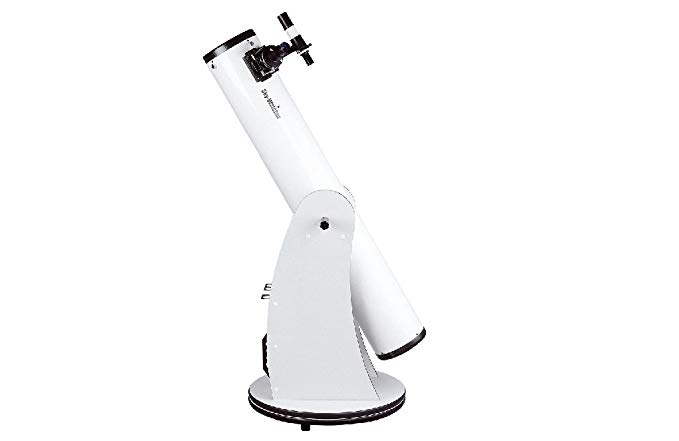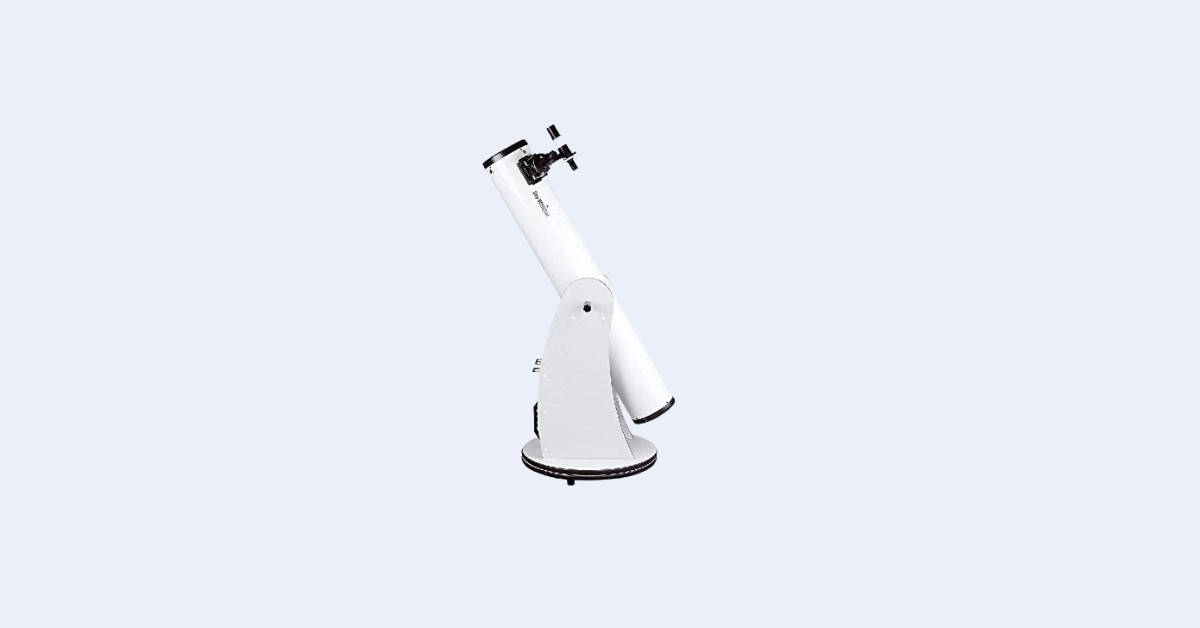The Optical Tube Performance Of Skywatcher 6″ Dob
The Skywatcher Classic 150 Dobsonian uses basically the same optical tube as the Orion XT6. It’s a 6” f/8 Newtonian – a design that is fairly easy to manufacture to tight tolerances. The f/8 focal ratio also means that the scope works well with cheap eyepieces like the “Supers” that come with it (these eyepieces will have astigmatism and other problems in faster scopes), and the 1200mm focal length puts the eyepiece at a good height for children or adults who are sitting down. The tube will fit across the back seat of most vehicles, though probably not in the trunk or boot of a smaller car.

The focuser on the 6″ Traditional is a single-speed, 2″ rack-and-pinion that is mostly made of metal. This is different from the 1.25″ plastic rack-and-pinions that are found on almost all cheaper scopes. I find the focuser works quite well for visual use, but the adapter system Sky-Watcher includes is a bit confusing, requiring you to swap out 2” and 1.25” extension tube adapters depending on which size eyepiece/accessory you are using. You can get a 2” to 1.25” compression ring adapter and leave the 2” extension tube in all the time to solve this, however. The 2” eyepiece format allows you to get a wider field of view than possible with 1.25” eyepieces at low magnifications, making it easier to find targets and fit larger ones in one field. But with the 2″ eyepieces that have the widest field of view, there may be some vignetting because the scope’s secondary mirror isn’t big enough to fully light the field of view of all 2″ eyepieces.
Included Eyepieces and Finderscope
In addition to its ubiquitous 1.25” and 2” extension adapters, the 6” Traditional includes two 1.25” “Super” eyepieces, which seem similar to Plossls—a 25mm (48x) and a 10mm (120x). These eyepieces will serve you well to start, but we’d recommend picking up additional eyepieces down the road if your budget suits them, to get the most out of the scope.
The included finderscope is a rather basic 6×30 unit, which works just fine for me, but I find the aperture a little small and the images dim as a result, with ergonomics that are less than ideal.
The Traditional Dobsonian Mount of Classic 150P
The 6” Traditional uses the same mount design as the larger Traditional Dobsonians. The altitude motion is provided by two round plastic bearings riding on Teflon cylinders attached to the interior of the mount. Tensioning is provided by a spring-loaded knob (basically just a bicycle handle and a hardware store spring) on one side; the other knob serves no purpose besides aesthetics/symmetry. Overall, the altitude bearing system works well. It may be better than the spring system on the Orion Dobsonians, but it isn’t as good as the GSO/Zhumell bearing style. The knobs, on the other hand, stick out and tend to catch on your clothes or bump into you, which is annoying. The azimuth movement of the telescope is made possible by small nylon pads that run directly against the melamine coating that covers the whole base. This coating is not perfect, but it is smooth and stable for the most part.
Like all commercial Dobsonians I’ve seen lately, the entire base of the telescope is made out of particle board and was easily assembled just like IKEA furniture with the included Allen wrench and screwdriver.
What can you see with Skywatcher Classic 150P?
I agree with most people that a 6 inch aperture is the smallest size that is good for serious viewing of deep-sky objects like the Messiers and many of the NGC objects, like the Herschel 400, while still being cheap and portable.
You’ll be able to resolve the brighter globular clusters, such as M13, M15, and M3, into individual stars with no problems. The 6” Traditional also makes an ideal lunar, planetary, and double star instrument.
You won’t have any trouble seeing the ice caps and dark areas of Mars around opposition, the phases of Venus and Mercury, or the thousands of craters on the Moon that are anywhere from a mile to hundreds of miles across. Jupiter’s moons, cloud belts, polar zones, festoons, and its (slowly-shrinking) Great Red Spot are visible. You can see Saturn’s rings, the Cassini division inside them, some faint cloud banding, and about half a dozen moons. Uranus and Neptune are teal and azure dots, and you may just be able to spot Neptune’s moon Triton with dark and steady skies. The 6” traditional can also split double stars as close together as 0.75 arc seconds apart, and will reveal thousands of asteroids to the keen-eyed observer (though keep in mind that none will look like anything more than slow-moving, stellar dots).
Alternative Recommendations
The Sky-Watcher 6” Classic is one of our top picks in its price range, though there are a few other 6” telescopes you might want to consider instead – or even better, upgrading to an 8” reflector.
Under $500
- The Sky-Watcher Virtuoso GTi 150P – or its manual sibling, the Heritage 150P, are a lot more compact than the 6” Classic and the f/5 focal ratio offers a much wider possible field of view – though it’s more demanding on eyepieces. The GTi mount provides full motorized tracking and GoTo capabilities, while the tabletop design and collapsible tube of the 150P make transport and storage a lot easier.
- The Orion SkyQuest XT6 has spring-tensioned altitude bearings which are an improvement on the bicycle brake handles of the 6” Classic, a superior 2” Crayford focuser with a brass compression ring and no silly adapters, and an easier to use red dot finder for aiming.
$500-$700
- The Apertura AD8/Zhumell Z8/Orion SkyLine 8 (all of which are identical) offers nearly double the light gathering ability and 30% more resolving power of a 6” Dobsonian like the 6” Classic. You also get a dual-speed 2” Crayford focuser, a superior mount design, a 9×50 right-angle finder, and a high-quality 30mm SuperView 2” wide-angle eyepiece with this excellent telescope package.
- The Orion SkyQuest XT8 has a similar performance boost over the 6” Classic but only comes with a single speed (though still very nice) 2” Crayford focuser, red dot finder, and a single low-power 25mm Plossl eyepiece.
For more information on what telescope is best for you and your budget, check out our Telescope Rankings and Best dobsonian telescopes article.
Aftermarket Accessory Recommendations
The #1 accessory we’d recommend for the 6” Traditional are extra eyepieces. Specifically, a 2” wide-angle eyepiece such as the GSO 42mm SuperView, and a high-power eyepiece such as a 6mm goldline or a 5.5mm Meade UWA. The wide-angle 2” eyepiece will make it easier to find objects and provide a sweeping vista that’s great for the largest star clusters and nebulae, while either of the latter eyepieces will provide great close-up, high-magnification views of the Moon, planets, double stars, and globular star clusters.
Additionally, a Telrad or Rigel Quikfinder is a great supplement or replacement for the scope’s included 6×30 finderscope.




Do I need to buy a tripod to use the Sky-Watcher 6” Classic Dobsonian straight out of the box?
No, it sits on the ground
G’day Zane . Asking for best recommendation on additional eyepieces for my Sky-Watcher 6” Dobsonian classic. Just purchased it and waiting for delivery. Can’t wait to view the stars with out of the box conditions , but want those extra, pieces to have asap . To enhance our experience. I know I can get an adapter to go from 1.25 to 2” eyepieces easily without changing the other bit . So what’s your thoughts mate ? Requesting from Australia mate . Thanks cobber .
32mm Plossl for low power, 14-16mm wide-angle of your choice for medium, 9mm redline/goldline for high power, and either a Barlow or 4-5mm planetary eyepiece (BST, TeleVue or Explore Scientific would be my pick, not super familiar with available brands/products in Australia)